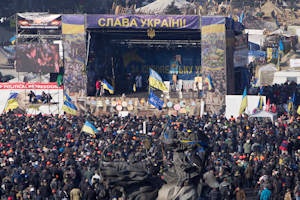Countries most at risk from Ukraine-style revolt identified
06 Mar 2014
A teaching tool developed to investigate the relationship between digital technology and political upheaval has correctly identified Ukraine as the country most-likely to undergo a revolution.
 Developed by Professor Richard Heeks from The University of Manchester's Centre for Development Informatics, the 'Revolution 2.0 Index' of 39 countries places Argentina, Georgia, the Philippines, and Brazil as the next most at risk regimes.
Developed by Professor Richard Heeks from The University of Manchester's Centre for Development Informatics, the 'Revolution 2.0 Index' of 39 countries places Argentina, Georgia, the Philippines, and Brazil as the next most at risk regimes.
All five countries, says Professor Heeks, have seen mass protests that are increasingly enabled and encouraged by digital technology.
While Georgia is not seen as being at immediate risk of regime change, governments of the other four countries have all been under pressure in the wake of huge demonstrations.
Professor Heeks says, ''I created this Index in 2013 as a teaching, not a predictive tool, following the much-publicised role of social media such as Facebook and Twitter in the Arab Spring.
''So I was fascinated that it identified Ukraine as the country most-likely to undergo a revolution.
''Clearly, revolutions arise from a mass of highly-complex factors that no simple calculation can hope to reflect let alone predict.
''But nevertheless, the Index does expose the significant national differences in both the drivers to mass political protest, and the ability of such protest movements to freely organise themselves online.''
The Index focusses on how repressive a country's regime is, using the Economist's Democracy Index, and how freely citizens can inform and organise protests via cyberspace, using data from Freedom House and the International Telecommunication Union.
High-scoring countries are those where political freedoms are compromised but internet freedoms are not – at least for the moment.
He adds, ''In Ukraine, the international media has focused on mass protest, shootings, ransacked buildings, standoffs with Russia.
''But social media has been the core tool used to organise protests and maintain them by letting protestors know where they can get nearby food, shelter, medical attention, and so on.
''It has spread word about violence and has garnered support and assistance from overseas.
''Opposition movements may take heed of the Index and develop core internet-based capabilities.
''But another lesson from the index may be less palatable: regimes can attack oppositions by developing those capabilities as well.
''Many regimes are indeed doing just this, making cyberspace a domain for control and surveillance of opposition supporters.''













.jpg)






.jpg)









